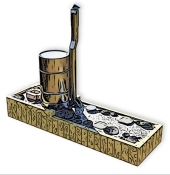I’m new to RMHs and just finished watching some of the Better Wood Heat DVDs (specifically the Fire Science and Pebble Style RMH videos). After watching those I was going to go with the 8” pebble-style J-tube design from the 2021 Jamboree (
https://permies.com/wiki/193712/Plans-Pebble-Style-Rocket-Mass). But then I came across Matt Walker’s website (e.g.,
https://walkerstoves.com/batch-rocket-mass-heater-plans.html) and am now wondering whether that’s a better approach for me. I’m trying to figure out what type of RMH to install in two structures that we’ll be building in the spring – a tiny house and yurt.
I was leaning towards pebble style instead of cob because cob seemed like it would require much more labor, be more difficult to move at a later time if needed, and require more expertise (i.e., in working with cob) than the pebble style. Though I like the aesthetic and flexibility of shaping that comes with cob (e.g., so that you can shape a comfortable bench) and perceive that as the major downside of not going with cob.
But if I’m not going with cob, I wonder if one of the Walker brick-based systems would make more sense. It seems more logical to use brick instead of wood to build the bench portion – more logical in that you’d be building it with a material that has high thermal mass. I’m new to both woodwork and masonry, so I don’t know that the learning curve on building the brick structure would be any steeper than learning how to build the wood box. I also like the flexibility of the different types of Walker stoves and might want to build a tiny masonry cook stove in our tiny house and then a batch box RMH in our yurt.
I also wonder if it would be easier to get a Walker stove past our building code enforcer since it looks more similar to other masonry stoves. I’m not familiar with building code for masonry stoves myself – anyone know if Walker stoves would easily meet those code requirements?
Lastly, in an effort to help spread RMHs and in an effort to teach youth these skills, I’d like whatever I build to be a pilot that I can work on with teens in the homeschooling program I run (
https://thisiscommunitas.org). I already have two teens interested in building projects like this, one of whom wants to go into masonry as her career. After we’ve built a few, we’d like to eventually start selling them elsewhere in the community with continued help from teens in our program (as an additional revenue source for our homeschool program). So I wonder if the brick approach might somehow be better from this perspective – it might be aesthetically more appealing to people in the community who might want to purchase one and the brick laying skills might translate to other interesting projects that I could pursue with the youth in our program in the future.
The only lingering question I have about the difference between a brick Walker stove vs a pebble style RMH is how they compare in terms of radiant heat. I thought that most of the radiant heat comes from the barrel riser. Would a comparable amount of radiant heat be coming off of the brick riser portion of the Walker RMH?
My mind’s been spiraling in an endless loop of indecision about what approach to take, so I’d really welcome people’s thoughts on all of this. If there are any other considerations I’m not thinking of, please let me know! Thanks everyone!!








